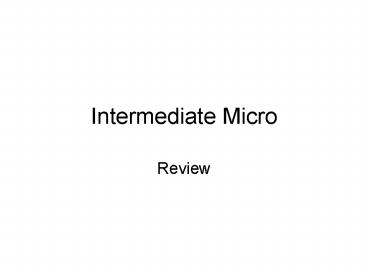Intermediate Micro - PowerPoint PPT Presentation
1 / 19
Title:
Intermediate Micro
Description:
General Equilibrium Edgeworth box. Monopoly and Pricing strategies ... Entry deterring strategies Ch 14. Pre-commit to entry deterring quantity or accommodate entry ... – PowerPoint PPT presentation
Number of Views:47
Avg rating:3.0/5.0
Title: Intermediate Micro
1
Intermediate Micro
- Review
2
Overview
- Competitive Markets Demand and Supply,
Equilibrium - Behind Demand Consumer Choice
- Behind Supply Producer Choice
- Adjustments and Efficiency
- General Equilibrium Edgeworth box
- Monopoly and Pricing strategies
- Oligopoly Cournot, Bertrand, Stackelberg
- Monopolistic Competition
- Market entry games
- Choice under uncertainty
- Externalities
- Asymmetric Information
3
Competitive markets Ch 2
- Demand, Supply and Equilibrium
- Shifts due to changes in other goods prices or in
consumer income or in cost to firms - Algebraic and graphical solutions
- Price ceilings and floors
- Taxes and Subsidies
- Test 1 question 1
4
Elasticities Ch 3
- Own price demand elasticity
- Cross price demand elasticity
- Income demand elasticity
- Supply price elasticity
- Percent change Q / Percent change in
- Own price
- Cross price
- Income
5
- Test 1 Question 1
- Test 2 Question 3
6
Behind DemandConsumer Choice Ch 4
- Preference axioms
- Utility functions and indifference curves
- MRSchange in Qy / change in Qx MUx/MUy
- Substitutability
- Perfect substitutes
- Perfect complements
- Budget constraints
- Optimum MRS Px/Py
- MUx/Px MUy/Py
- Test 1 Question 3
7
Changes in Demand Ch 5
- Changes in prices or income affects budget
constraint new optimum - Deriving demand curves and Engel curves
- Income and Substitution Effect
- Test 1 Question 2
- Test 2 Question 1
- Labor Leisure choice and labor supply
- Test 1 Question 2
8
Behind SupplyTheory of the Firm Ch 6
- Production Functions
- Short run one factor is fixed (capital)
- Diminishing Marginal Product of Labor
- Long run all factors are variable
- Isoquants
- Isocosts
- Optimal input allocation MRTS w/r change in
Qk/change in QL MPL/MPK - Returns to scale
- Test 1 Question 4
9
Cost Functions Ch 7
- Short run costs
- Diminishing MPL
- Increasing MC
- AVC, AFC, ATC
- MCAVC at min, MCATC at min
- Long run costs
- AC depends on economies of scale
- MC AC at min
10
Profit Maximization Ch 8
- Firms profit function TR TC
- Firms optimal output decision MRMC
- Competitive markets PMR
- Short run supply sum of MC curves across firms
- Long run supply zero profits after entry and
exit, PMCAC min - Test 1 Question 5
11
Market Efficiency Ch 9
- Consumer Surplus
- Producer Surplus (Profits)
- Government budget
- Deadweight Loss
- PMC maximizes market efficiency
- Loss in efficiency due to government intervention
- Taxes and Subsidies
- Restricting number of firms
- Trade and trade restrictions
- Test 2 Question 3
12
General Equilibrium Ch 10
- Multiple Markets
- Qx10-PxPy Qx2Px
- Qy20-2PyPx Qy5Py
- 10-PxPy2Px
- 20-2PyPx5Py
- Py5 5/7
- Px7 6/7
13
General Equilibrium Ch 10
- Edgeworth box with barter
- Pareto optimality
- Edgeworth box with competitive exchange at given
price - Equilibrium requires zero excess demand and
supply - Production, production possibilities frontiers,
and Edgeworth boxes
14
Monopoly Ch 11
- MR MC
- Lerner index (p-MC)/p -1/e
- Higher markup if demand is inelastic
- Effects of monopoly compared to competitive
equilibrium (PMC) - Smaller Q
- Higher P
- Loss in Market Efficiency deadweight loss
15
Pricing policies Ch 12
- Perfect price discrimination
- PWTP for each consumer
- All consumer surplus becomes monopoly profits
- Output is same as for competitive market no
deadweight loss - Multi-market price discrimination
- Elastic and inelastic markets
- MR differ across markets
- MR(1) MR(2) MC
- MR(1) P(1) 1 1/e(1) P(2)11/ e2) MR(2)
- Two-part tariff
- PMC and then charge each consumer their consumer
surplus as fixed membership fee - PgtMC may be justified if consumer surplus differ
across people but only one fixed fee and unit P
can be set - Bundling
- WTP of different consumers across different goods
has opposite pattern
16
Oligopoly and Monopolistic Competition
- Cournot duopoly
- Simultaneous moves in Q
- Stackelberg duopoly
- Sequential moves
- Bertrand duopoly
- Simultaneous moves in P
- Monopolistic Competition
- No entry barriers, profits0, PgtMC
17
Entry deterring strategies Ch 14
- Pre-commit to entry deterring quantity or
accommodate entry - Incumbent (Leader) figures out respondents best
response to each possible incumbent decision - Based on entry cost find out for which Q(L) that
the entrant would make a loss - Can the incumbent make more profits at these Q(L)
than at the Stackelberg equilibrium
(accommodating entry)?
18
Choice under uncertainty Ch 17
- Expected values (EV)
- Variance
- Expected utility
- Utility function is concave for risk averse
people, convex for risk preferring, and linear
for risk neutral - Diversification can lower the variance without
lowering the EV
19
Externalities Ch 18
- Positive and Negative Externalities
- Private, external and social MC
- Private equilibrium and Social optimum
- Deadweight losses from private equilibrium with
negative (or positive) externalities - Coase theorem































